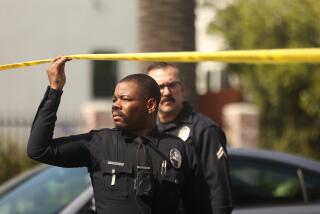Juvenile Crime Is Decreasing--It’s Media Coverage That’s Soaring
- Share via
Recently, as it has every fall since 1993, the Justice Department announced a significant 11% decline in serious and violent juvenile crime over the previous year--double the percentage of decline in adult crime. Yet how can juvenile crime be dropping when we seem to be watching young bodies being wheeled out of schools on gurneys nightly on the news? One explanation is because saturation coverage of the acts of a handful of kids is skewing our nation’s understanding of crime by youth.
This kind of coverage began in earnest two years ago, after two shocking killings by juveniles in the same week, one in New Jersey involving 15-year-old Sam Manzie, who killed an 11-year-old boy who was selling candy door to door, and the other in Pearl, Miss., involving 16-year-old Luke Woodham, who stabbed his mother to death, then shot two classmates and wounded several others.
At that same time, virtually unnoticed by the press, Atty. Gen. Janet Reno announced juvenile crime data showing a significant 30% decline in juvenile homicides over the previous three years.
The Mississippi killing was the first of a trend--not of increasing school shootings but of increasing media coverage of such shootings and other juvenile crime--that has lasted to the present day. According to the Berkeley Media Studies Group, most of the time when kids are depicted on the evening news, it is in connection with violence, even though less than one-half of 1% of juveniles were arrested for a violent crime last year. Indeed, this trend holds true for all crime coverage. Between 1992 and 1996, while the homicide rate in the United States dropped by 20%, coverage of homicide on the ABC, NBC and CBS evening news increased by 721%, according to a survey by the Center on Media and Public Affairs. Not surprisingly, polls showed six times as many people ranking crime as the No. 1 problem in 1993 as did in 1992, and fear of crime has been at or near the top of the polls every year since.
To be sure, the rates of adult and juvenile crime are higher now than in the 1960s, although rates for both have been declining since the early 1990s. Yet one-third of Americans believe that crimes committed by adults are on the increase and even more--two-thirds--believe that juvenile crime is on the increase. Why? Perhaps it’s the connection to highly publicized schools crimes.
Nowadays, it is impossible to talk about juvenile crime and not discuss school shootings. Yet school shootings are extremely rare and are not on the increase. In a population of about 50 million schoolchildren, there were about 55 school-associated violent deaths in the 1992-93 school year and fewer than half that in the 1998-99 school year. By comparison, in 1997, 88 people were killed by lightning--what might be considered the gold standard for idiosyncratic events. Children who are killed in the United States are almost never killed inside a school. Yes, 12 kids were killed at Columbine. But by comparison, every two days in the U.S., 11 children die at the hands of their parents or guardians.
In addition, kids are not killing one another at an increasing rate. In fact, they rarely kill one another. Less than 3% of the homicides in the U.S. involve someone under 18 killing someone else under 18. Killings by children under 13 are at the second-lowest rate since that statistic began being kept in the mid-1960s.
Failure to put juvenile crime into context has resulted in a public that is not just misinformed but profoundly misguided about how teenagers are behaving. Polls show that Americans believe that juveniles are responsible for 43% of homicides; they actually are responsible for about 9%. As stated previously, nearly two-thirds of Americans think juvenile crime is on the increase, while there has been a 58% decline in juvenile homicides since 1994. Although there was less than a one-in-a-million chance of being killed in a school last year, 71% of respondents to a May 1998 Wall Street Journal poll believed that such a killing was likely in their school. In a Washington Post poll released in early November, almost two-thirds of parents listed school violence as something “worrying them the most these days.”
Politicians are fed back these fears and misconceptions about juvenile crime, which they talk about and legislate about, closing the media-public opinion-policymaking loop. In supporting his Violent Youth Predator Act of 1996, which would have jailed some kids with adults upon arrest, Rep. Bill McCollum (R-Fla.) stated: “They’re the predators out there. They’re not children anymore. They’re the most violent criminals on the face of the Earth.” This comment was made not by a rogue Congress member but by the chairman of the House Judiciary Committee’s subcommittee on crime.
It is no more fair to stereotype U.S. high school students as Luke Woodham than it would be to taint all adults with the sins of Timothy McVeigh. Our kids are the ones on the other side of the yellow tape, weeping over the death of their classmates, just like the rest of us. As we set public policy, that is something we need to remember.
More to Read
Sign up for Essential California
The most important California stories and recommendations in your inbox every morning.
You may occasionally receive promotional content from the Los Angeles Times.













